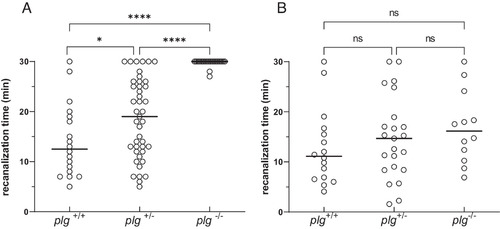Fig. 5
- ID
- ZDB-FIG-240422-28
- Publication
- Pontius et al., 2024 - Magnetically powered microwheel thrombolysis of occlusive thrombi in zebrafish
- Other Figures
- All Figure Page
- Back to All Figure Page
|
µWheel-mediated recanalization of occlusive thrombi is dependent on plasminogen. (A) CRISPR-mediated genome editing was used to produce a 23 base pair deletion in the plg gene. In the majority of wild-type (n = 18) and heterozygous (n = 43) mutants, µwheels were able to recanalize an occlusive thrombus within 30 min. Conversely, the vast majority of homozygous (n = 20) mutants were unable to do so. Interestingly there was a small, but statistically significant decrease in the percentage of heterozygotes that were able to recanalize, when compared to wild-type siblings. (B) Plasminogen was infused into plg mutant fish [wild-type (n = 16), heterozygous (n = 23), homozygous (n = 12)] and µwheels were able to recanalize the majority of occlusive thrombi within 30 min. Observations were performed prior to genotyping and thus were blinded. Bars represent median recanalization time. (*P < 0.05, ****P < 0.0001 by Mantel-Cox log-rank testing), ns, not significant. |

